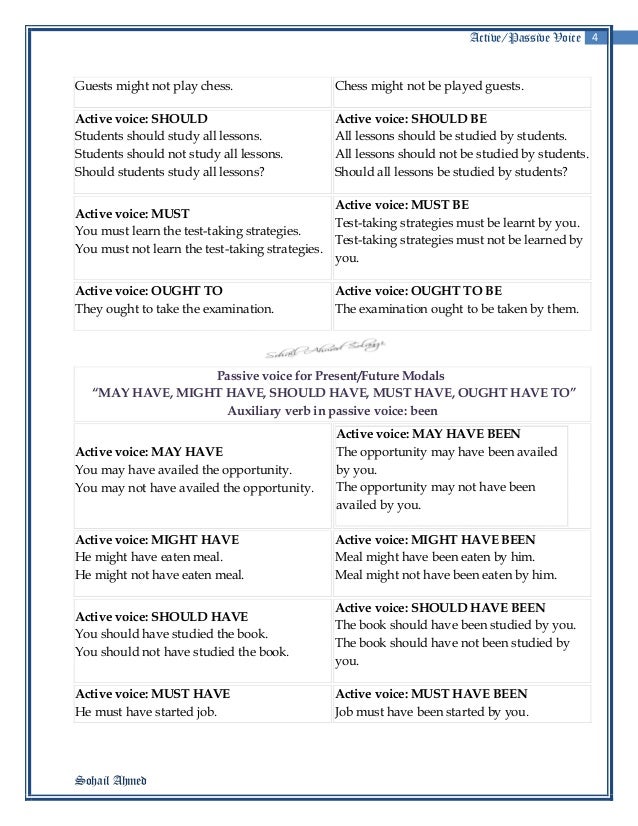Form of the English Passive Voice. In English, as passive verb is formed by combining a form of the verb “to be” with the participle of a transitive verb (usually a past participle). Examples “The ball was thrown” “The food is being cooked” Form of the Hindi Passive Voice. In Hindi, passive verbs are formed by combining a perfect. Read each of the following examples of this kind of passive voice construction. In your head, think of a way to reword the sentence to make it more interesting by using an action verb. In your head, think of a way to reword the sentence to make it more interesting by using an action verb. Active and Passive Voice. In the above example of an active sentence, the simple subject is “chef” and “prepares” is the verb: the chef prepares “each meal with loving care.” In the passive sentence, “meal” is the. The following is a summary of active and passive.
An action of a subject, in relation to an object, is expressed in two ways. These two ways of expressing action of a subject are known as Voices. Kursus bahasa inggris online.
1. Active Voice
2. Passive Voice
Example.
I write a letter. (Active Voice)
A letter is written by me. (Passive Voice)
The structure of same sentence changes when expressed as Active Voice or Passive Voice. The meaning of a sentence, either expressed as Active Voice or Passive Voice, remains the same.
Difference between Active Voice and Passive Voice.
The meaning or main idea of sentence, either expressed as Active Voice or Passive Voice does not change. The structure of a same sentence changes for Active Voice and Passive Voice. We know that every sentence have a subject, a verb and an object. Subject is an agent who works on an object in a sentence. In the above example, “I” is the subject of the sentence that is doing some work on the object ‘letter’ in the same sentence.
Active And Passive Voice Rules With Examples In Hindi Pdf Online
To understand the difference in both voices, we should focus on the subject and the object of a sentence. In Active Voice, the subject acts upon the object. In Passive Voice, the object is acted upon by the subject. The meaning remains the same in both Voices but the sequence of the words (subject & object) changes. The sequence, of subject and object as in Active Voice, is reversed when it is expressed in Passive Voice. Read the following example for better understanding this difference.
| Active Voice | Passive Voice |
|---|---|
| I eat an apple. | An apple is eaten by me. |
| He bought a car. | A car was bought by him. |
The sequence of the subject and the object of the sentence is reversed while converting the sentence from Active Voice to Passive Voice.
The structures of a same sentence, for both Voices, are as follows:
Active Voice: Subject + Verb + Object
Passive Voice: Object + Verb + Subject

Basic Rules For Changing Active Voices Into Passive Voices
Rule No. 1. As mentioned earlier, the structure of sentence will be reversed in Passive Voice. The places of the Subject and the object will interchange. The subject will shift to the place of Object and the object will take the place of Subject in Passive Voice.
Example:
Active Voice:He buys a camera.
Passive Voice:A camera is bought by him.
Rule No. 2. Only Past Participle Form or 3rd form of verb (e.g. eaten etc) will always be used as main verb in Passive voices for all tenses. No other form of verb will be used as main verb. It can be seen in all the examples given on this page.
Rule No. 3. The word “by” will be used before subject in the Passive voice.
Example:
Active Voice: She drinks water.
Passive Voice: Water is drunk byher.
Rule No. 4. Other words such as ‘with’ or ‘to’ may also be used instead of word ‘by’ depending upon the subject of the sentence. These words are used in a very few cases. The word ‘by’ is used in the most cases.
Examples:
Active Voice:: I know him.
Passive Voice: He is known to me.
Active Voice: Water fills a tub.
Passive Voice: A tub is filledwith water.
Rule No. 5. The auxiliary verb will be changed in Passive Voice depending upon the tense of sentence in its Active Voice. There are rules for changing the auxiliary for each tense which can also be studied on this website.
Rule No. 6. Subject may not be always mentioned in Passive Voice. Passive voice for some sentences can also be written without having subject, if it gives clear idea about the subject. Read the following examples.
Examples:
Passive Voice: Women are not treated as equals.
Passive Voice: Sugar is sold in kilograms.
Note: The above rules, except rule No. 5, are the basic rules for changing Active Voices into Passive Voice and apply to all type of sentences. The rule No. 5 is about the usage of auxiliary verbs in Passive Voices which differs for each tense of the sentence. These rules for each tense have also been explained on this website.